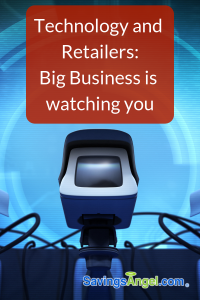Technology and Retailers: Big Business is watching you
When vying for your dollars, the use of technology has given retailers a stronghold of advantages in recent years. Now they have a new weapon against fraud and shoplifting. Facial recognition. Honest shoppers would likely applaud without realizing it affects them as well. (After all, fraud raises prices for everyone.) But it’s also a good way for retailers to identify shoppers who aren’t a threat – and use that to increase their bottom line. Welcome to the reality of technology and retailers. Big business is watching you.
Many consumers do not realize that this type of technology has already been implemented and tested for years now. We just aren’t necessarily told. Businesses like Macy’s, Target and Walmart have been using the ability to track consumers for years. According to Joseph Turow, author of “The Aisles Have Eyes: How Retailers Track Your Shopping, Strip Your Privacy and Define Your Power”, Walmart has even tested using lighting to communicate with your mobile device and use its camera to track you.
Privacy Issues
That brings forward the top concern of scanning customers – privacy issues. Cameras watching your every move in retail locations have been the normal operating procedure for years. Newer technology goes beyond this. And now, FaceFirst, a leading developer of facial recognition technology, has readied a new application called Fraud-IQ. It scans every customer and enters them into a database, whether the customer wishes it or not. Retail return fraud and shoplifting costs retailers billions annually. It follows that finding a way to slow this financial bleeding is a priority to retailers. So software like Fraud-IQ is likely coming to a store near you soon. It’s inevitable.
As for the consumer, data aggregation of purchase history, how often you shop, your income, age, family status, social media interaction, and more is being used. Due to extensive integration of the technology we use every day, stores can even pull up the details of items you considered for purchase online to try to land the sale in-store when you walk through their doors. Now they can also match it to your face, giving the retailer upper hand by having all your data the moment you enter and seizing the opportunity to try to upsell you.
Did you opt-in?
Consumers can already opt-in to features of store apps that will alert them to a special “for you only” coupon or offer because they are scanned considering a specific product. (Often called “beacon technology”.) But the key word is opt-in. You have to activate the store’s app and often also use their loyalty card or program of some kind. If you don’t use their app, the store does not get “real time” data on you as you peruse the aisles. They only get information on you after you pay. With facial recognition, consumers can be recognized immediately – and all of their data pulled up.
The concern is that consumers are not able to “opt-in or opt-out” of this identification. It just happens. Legally, stores are already within their rights to watch and track customers. So will updating store loyalty programs, for example, to include agreeing to this type of technology be on the horizon? Will public distrust prompt retailers to be more forthcoming in 2019? Time will tell.
For retailers, the application of pairing facial recognition with your known data gives the store all they need. An associate can approach you and, they hope, influence your buying decisions. But where is the benefit to the consumer for the release of all this information about themselves? In many instances, consumers get offers for special coupons or additional discounts. This makes the exchange at least a touch more equitable.
Technology and price discrimination
However, as Turow warns, this technology can also be used to actually increase the price you pay. Price discrimination is not illegal in the United States. Retailers are within their rights to use the information they have about you. Which can be used to increase the price you pay at the register. Furthermore, Turow points out, this use of technology to trigger price discrimination could create an entirely new culture of consumers. Some may try to crack the pricing and customer demographics algorithm just to be offered better prices and extra discounts. People may feel forced to seek ways to “improve” their customer profile simply to avoid falling victim to price discrimination.
Currently, where does this leave consumers who might want more coupons or deals offered to them but don’t feel comfortable being scanned at every turn? It seems there is little we can do to restrain what retailers know about us. And, unfortunately, we’ve probably all have been scanned plenty of times without knowing. Fortunately, for now, good old fashioned coupons are still available to help you save. Although, they are often wrapped in technology too. Perhaps being so digitally “known” is simply unavoidable.

